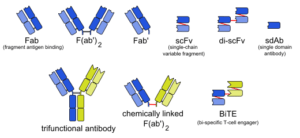When CD4 T cells are infected with HIV, CD8 cytotoxic T cells usually move in to kill the infected cells. However, some CD4 T cells accumulate in germinal centers of secondary lymphoid organs. CD8 T cells are not usually found in these organs, which allows HIV to replicate much more freely. Researchers from the National Institute of Allergy and Infectious Diseases, USA, discovered that CD8 cells could be found in the germinal centers of HIV-infected individuals. While these CD8 T cells were less effective in releasing cytokines, they were still able to kill HIV-infected cells. Combined with a bispecific antibody, these follicular CD8 T cells have significant implications.
Lymph node tissue and residing T cells were characterized amongst HIV positive and HIV negative donors. The researchers evaluated CD8 T cell traits such as location, phenotype, and the expression of chemokine receptors, using flow and histo-cytometry, as well as confocal imaging. An anti-HIV and anti-CD3 bispecific antibody was constructed to demonstrate HIV-infected cell killing ability. Significant differences were found in the cell killing and flow cytometry assay between follicular and non-follicular CD8 T cells. In a healthy individual, CD8 T cells are not abundantly found in germinal centers. Petrovas et al. showed that HIV infection can change the phenotype, frequency, and localization of CD8 T cells within lymph nodes. This did not seem to be caused by an increased concentration of HIV within the lymph node. Instead, it seemed to be associated with a chronic, local immune infection. Though there was increased B cell follicle-originating CD8 T cells correlated with immune activation, it was not correlated with viral replication. Furthermore, follicular CD8 T cells were found to have impaired cytokine-releasing function by anti-CD3 stimulation and typical chemokine expression in HIV-infected patients.
Thus, researchers have successfully demonstrated that in vivo follicular CD8 cells have a potential HIV-killing pathway. The newly observed follicular CD8 cells has provided a framework for a potential cure of HIV.
Article by Maxwell Chan and Rebecca Ng












